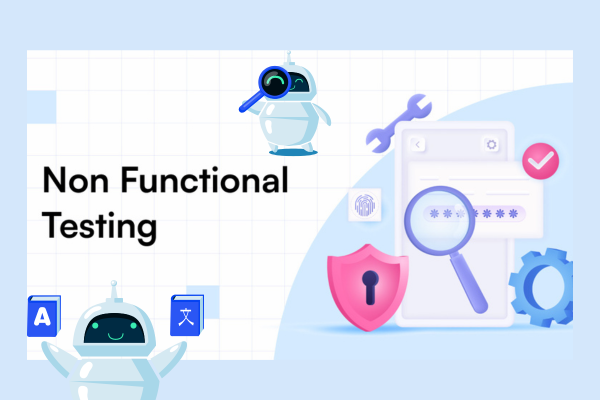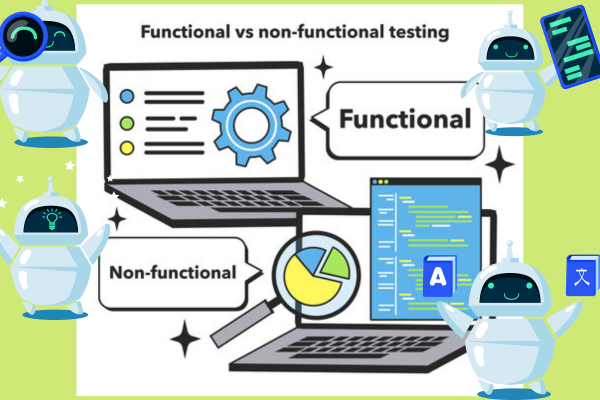In the world of software development, testing plays a critical role in ensuring that a product is reliable, efficient, and user-friendly. Software testing is generally categorized into two broad areas: functional testing and non-functional testing. Both serve distinct purposes, but together, they ensure that a software application is both technically sound and meets user expectations. In this blog, we’ll explore these two categories and their respective types in detail.
Table of Contents
What is Functional Testing?

Functional testing is the process of testing the software to ensure that it functions according to the specified requirements. This type of testing focuses on verifying that the application behaves as expected when the user interacts with it. Functional testing checks the various features and functionalities of the software by feeding it inputs and comparing the output with the expected results.
Key Objectives of Functional Testing:
- To verify that the software works as intended.
- To ensure that all user requirements are met.
- To identify any defects or issues in the software.
Types of Functional Testing

Functional testing includes several different types, each focusing on different aspects of the software’s functionality. Below are some common types of functional testing:
- Unit Testing:
- Definition: Unit testing is the process of testing individual components or modules of a software application in isolation.
- Purpose: To ensure that each unit of the software performs as expected.
- Example: Testing a login function to verify that it accepts correct usernames and passwords and rejects incorrect ones.
- Integration Testing:
- Definition: Integration testing involves testing the interaction between different modules or components of the software.
- Purpose: To ensure that the integrated modules work together correctly.
- Example: Verifying that data flows correctly between the user interface and the database.
- System Testing:
- Definition: System testing is the process of testing the complete and integrated software system to validate its compliance with the specified requirements.
- Purpose: To ensure that the entire system works as a cohesive unit.
- Example: Testing an e-commerce website’s entire functionality, from browsing products to making a purchase.
- User Acceptance Testing (UAT):
- Definition: UAT is performed by the end-users or clients to verify that the software meets their needs and requirements.
- Purpose: To ensure that the software is ready for deployment from a user perspective.
- Example: Allowing beta testers to use the software and provide feedback before the final release.
- Regression Testing:
- Definition: Regression testing involves re-testing the software after modifications to ensure that the changes do not adversely affect existing functionalities.
- Purpose: To detect and fix any new issues introduced by recent changes.
- Example: Running previous test cases after a software update to ensure that no existing features are broken.
- Smoke Testing:
- Definition: Smoke testing is a quick, preliminary test that checks the basic functionality of the software to determine whether it is stable enough for further testing.
- Purpose: To ensure that the most critical functions of the software are working correctly.
- Example: Verifying that an application launches correctly and allows users to log in.
What is Non-Functional Testing?

Non-functional testing, on the other hand, focuses on how the software performs rather than what it does. This type of testing evaluates various attributes such as performance, usability, security, and compatibility. Non-functional testing ensures that the software not only works but also delivers a positive user experience.
Key Objectives of Non-Functional Testing:
- To verify that the software meets performance requirements.
- To ensure that the software is secure, reliable, and user-friendly.
- To identify any potential issues that could affect the user experience.
Types of Non-Functional Testing
Like functional testing, non-functional testing also includes several types, each targeting different quality attributes of the software. Here are some common types of non-functional testing:
- Performance Testing:
- Definition: Performance testing evaluates the speed, responsiveness, and stability of the software under various conditions.
- Purpose: To ensure that the software performs well under expected and peak loads.
- Types:
- Load Testing: Measures the system’s performance under normal and peak loads.
- Stress Testing: Tests the system’s behavior under extreme conditions.
- Scalability Testing: Evaluates the system’s ability to scale up or down to meet changing demands.
- Example: Testing how quickly a website loads when accessed by thousands of users simultaneously.
- Usability Testing:
- Definition: Usability testing assesses how easy and user-friendly the software is for end-users.
- Purpose: To ensure that the software is intuitive and easy to navigate.
- Example: Observing users as they interact with the software and collecting feedback on their experience.
- Security Testing:
- Definition: Security testing identifies vulnerabilities and ensures that the software is protected against threats such as unauthorized access and data breaches.
- Purpose: To ensure the confidentiality, integrity, and availability of data.
- Example: Testing for common security issues such as SQL injection, cross-site scripting (XSS), and data encryption.
- Compatibility Testing:
- Definition: Compatibility testing ensures that the software works correctly across different devices, browsers, operating systems, and network environments.
- Purpose: To verify that the software provides a consistent experience across various platforms.
- Example: Testing a mobile app on both iOS and Android devices to ensure compatibility.
- Reliability Testing:
- Definition: Reliability testing evaluates the software’s ability to perform consistently over time and under different conditions.
- Purpose: To ensure that the software is dependable and can operate without failure.
- Example: Running the software continuously for an extended period to check for stability and error rates.
- Compliance Testing:
- Definition: Compliance testing verifies that the software adheres to legal, regulatory, and industry standards.
- Purpose: To ensure that the software meets the necessary regulations and guidelines.
- Example: Checking that a financial application complies with PCI-DSS standards for handling credit card information.
- Localization Testing:
- Definition: Localization testing ensures that the software is adapted to different languages, cultures, and regions.
- Purpose: To verify that the software provides a relevant and accurate experience to users in different locations.
- Example: Testing a website’s content and layout in multiple languages to ensure correct translation and formatting.
- Maintainability Testing:
- Definition: Maintainability testing assesses how easily the software can be modified, updated, or repaired.
- Purpose: To ensure that the software can be efficiently maintained over its lifecycle.
- Example: Evaluating the codebase to determine how easily new features can be added or existing issues can be fixed.
Conclusion
Functional and non-functional testing are both crucial to the software development process. While functional testing ensures that the software meets its functional requirements, non-functional testing ensures that the software is reliable, efficient, and user-friendly. By combining both types of testing, developers can create a software product that not only works as intended but also delivers a high-quality experience to users. Each type of testing, whether it focuses on functionality or performance, plays a vital role in achieving the ultimate goal of delivering a successful software application.

